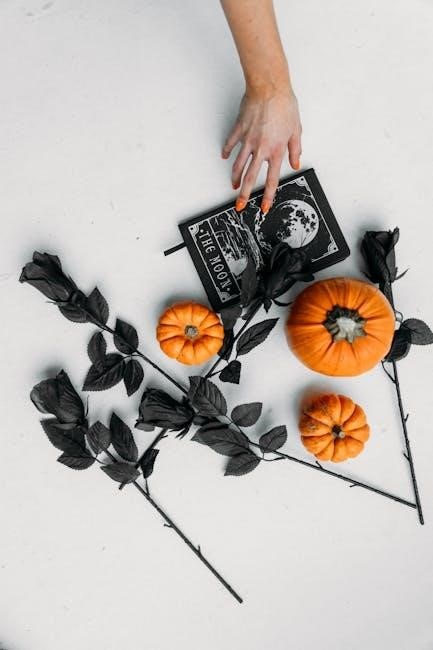Tarot guide books are essential tools for understanding tarot card meanings, spreads, and interpretations. They offer insights for beginners and advanced readers, helping deepen tarot practices and knowledge.
1.1. Importance of Tarot Guide Books for Beginners and Advanced Readers
Tarot guide books are indispensable for both beginners and advanced readers, offering comprehensive insights into card meanings, spreads, and interpretations. For beginners, they provide foundational knowledge, helping to understand symbolism, card positions, and basic spreads. Advanced readers benefit from deeper explorations of card symbolism, connections to astrology and numerology, and nuanced interpretation techniques. These books also serve as reference tools, aiding in refining skills and exploring complex themes. Whether you’re starting your tarot journey or seeking advanced insights, guide books are essential for enhancing your understanding and practice.

History of Tarot and Its Evolution
Tarot originated in 15th-century Italy as a game, evolving into a tool for divination and self-reflection. Its rich history spans cultural and symbolic transformations.
2.1. Origins of Tarot Cards and Their Symbolism
Tarot cards trace their origins to 15th-century Italy, initially used in a game called tarocchi. Over time, they evolved into tools for divination and self-reflection. The symbolism within the cards reflects archetypal themes and universal experiences, drawing from mythology, astrology, and alchemy. Early decks, like the Visconti-Sforza tarot, showcased intricate designs tied to courtly life and spiritual allegories. The Major Arcana cards, such as The Fool and The World, embody profound symbolic meanings, while the Minor Arcana reflects everyday situations. These symbols have been interpreted in various ways across cultures, making tarot a rich and adaptable system for understanding human consciousness and destiny.

Understanding the Tarot Deck Structure
A standard tarot deck contains 78 cards, divided into the Major Arcana and Minor Arcana. The Major Arcana represents major life themes, while the Minor Arcana reflects everyday situations and emotions through four suits.
3.1. Major Arcana vs. Minor Arcana: Key Differences and Significance
The Major Arcana consists of 22 cards representing major life themes, archetypes, and spiritual lessons, such as The Fool, The Lovers, and The Death. These cards symbolize significant events and transformations. In contrast, the Minor Arcana includes 56 cards divided into four suits (Wands, Cups, Swords, and Pentacles), resembling a traditional playing deck. Each suit explores everyday situations, emotions, and challenges, with cards numbered from Ace to 10 and including court cards (Page, Knight, Queen, King). While the Major Arcana highlights profound shifts, the Minor Arcana focuses on mundane experiences, providing a holistic view of life in tarot readings.
How to Choose the Right Tarot Deck
Trust your intuition, consider visual appeal, and choose a deck that resonates with your energy and personal journey for meaningful tarot experiences and deeper connections.
4.1. Tips for Selecting a Tarot Deck That Resonates with You
- Choose a deck with visuals that inspire you, as emotional connection enhances readings.
- Consider themes that align with your interests, such as astrology or nature.
- Explore deck reviews and descriptions to find one that mirrors your energy.
- Handle the cards to ensure the size and texture feel comfortable.
- Trust intuition—select a deck that feels “right” during your search.
Tarot Spreads and Their Meanings
Tarot spreads are structured layouts of cards used to explore specific life situations. They range from simple three-card spreads to complex arrangements, offering deeper insights.
5.1. Common Tarot Spreads for Different Life Situations
Common tarot spreads include the Three-Card Spread, Celtic Cross, and Relationship Spread. These layouts help address specific life challenges, offering clarity on past, present, and future. The Three-Card Spread is ideal for straightforward guidance, while the Celtic Cross provides in-depth analysis. The Relationship Spread explores dynamics between individuals, aiding in understanding conflicts and opportunities. Each spread serves a unique purpose, making tarot readings adaptable to various situations and personal needs.
Interpreting Tarot Cards
Interpreting tarot cards involves combining intuition with symbolism. Guidebooks like “Seventy-Eight Degrees of Wisdom” and “Tarot Plain & Simple” offer deeper insights, helping readers understand card meanings and connections.
6.1. Basic Steps to Interpret Tarot Cards and Their Positions
Interpreting tarot cards involves understanding their meanings, positions, and relationships. Start by studying the card’s symbolism, colors, and imagery. Consider its position in the spread, as it influences interpretation. Combine intuition with guidebook insights, like those from Tarot Plain & Simple or Seventy-Eight Degrees of Wisdom. Pay attention to card interactions and the overall narrative. For reversals, reflect on blocked or delayed energies. Use journaling to track patterns and personal associations. Practice regularly to refine your skills and deepen connections with the cards. This holistic approach enhances accuracy and meaningful readings for yourself and others.
Tarot and Astrology Connection
Tarot and astrology are deeply intertwined, with cards linked to zodiac signs and planets, enhancing interpretations. Guidebooks like Tarot and Astrology explore this cosmic connection, enriching readings.
7.1. How Tarot Cards Relate to Astrological Signs and Planets
Tarot cards are deeply connected to astrological signs and planets, with each card often linked to specific celestial influences. For example, the Magician card is associated with Mercury, symbolizing communication and skill. Guidebooks like Tarot and Astrology reveal how these connections enhance readings, offering deeper insights into personality traits and life events. By aligning tarot card interpretations with astrological principles, readers can uncover hidden meanings and patterns, making their readings more precise and meaningful. This cosmic interplay enriches the tarot experience, blending two ancient systems of wisdom.
Advanced Tarot Techniques
Advanced tarot techniques involve combining tarot with numerology, Kabbalah, and astrology for deeper insights. These methods, explored in books like Advanced Tarot Secrets, enhance readings and mastery.
8.1. Combining Tarot with Numerology and Kabbalah for Deeper Insights
Combining tarot with numerology and Kabbalah offers profound insights, enhancing readings. Numerology links card numbers to universal meanings, while Kabbalah connects cards to the Tree of Life, revealing deeper symbolism. Books like Qabalistic Tarot explore these connections, showing how numerological reduction of card numbers unlocks hidden truths. Kabbalistic principles align tarot with Jewish mysticism, offering a structured framework for understanding card relationships. This fusion allows readers to tap into ancient wisdom, enriching interpretations and fostering personal growth. Advanced practitioners use these techniques to uncover layered meanings, making readings more nuanced and impactful.

Ethical Guidelines for Tarot Readings
Ethical tarot readings emphasize respect for clients’ autonomy and privacy. Practitioners must avoid misleading statements and provide honest, supportive guidance while fostering a safe, non-judgmental environment.
9.1. Best Practices for Reading Tarot for Others
When reading tarot for others, prioritize ethical practices to ensure a positive experience. Respect clients’ autonomy and privacy, avoiding any form of manipulation or pressure. Be honest and transparent about the limitations of tarot, emphasizing its role as a tool for guidance rather than predicting fixed outcomes. Create a safe, non-judgmental space for clients to express themselves freely. Encourage clients to take personal responsibility for their choices and actions. Avoid making absolute statements that could cause unnecessary fear or anxiety. Foster trust by maintaining confidentiality and approaching each session with empathy and integrity.

Recommended Tarot Books and Resources
Top tarot guide books include The Ultimate Guide to Tarot, The New Tarot Handbook by Rachel Pollack, and Seventy-Eight Degrees of Wisdom, offering insights into symbolism, spreads, and practical tips for all levels.
10.1. Top Tarot Guide Books for Beginners and Advanced Practitioners
For beginners, The Ultimate Guide to Tarot and The New Tarot Handbook by Rachel Pollack are excellent, offering clear explanations and practical advice. Advanced practitioners may prefer Seventy-Eight Degrees of Wisdom, which dives deep into symbolism, or Queering the Tarot and Advanced Tarot Secrets for innovative perspectives. These books provide comprehensive insights, helping readers at all levels refine their tarot skills and deepen their understanding of the cards’ meanings and connections to spirituality, numerology, and astrology.

No Responses